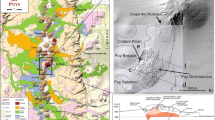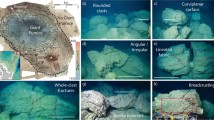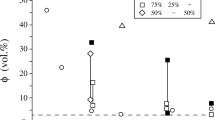Abstract
Textural characterization of pumice clasts from explosive volcanic eruptions provides constraints on magmatic processes through the quantification of crystal and vesicle content, size, shape, vesicle wall thickness and the degree of interconnectivity. The Plinian fallout deposit directly underlying the Campanian Ignimbrite (CI) eruption represents a suitable case to investigate pumice products with different textural characteristics and to link the findings to processes accompanying conduit magma ascent to the crater. The deposit consists of a lower (LFU) and upper (UFU) pumice lapilli bed generated by the sub-steady eruption of trachytic magma with <5 vol%. crystals and a peak discharge rate of 3.2×108 kg/s. Density measurements were performed on samples collected from different stratigraphic intervals at the Voscone-type outcrop, and their textural characteristics were investigated at different magnifications through image analysis techniques. According to clast densities, morphologies and vesicle textures pumice clasts were classified into microvesicular (heterogeneous vesicles), tube (elongated/deformed vesicles) and expanded (coalesced/inflated vesicles).The combination of density data and textural investigations allowed us to characterize both representative areas and textural extremes of pumice products. Bulk vesicularity spans a broad interval varying from 0.46 to >0.90, with vesicle number density ranging from 107–108 cm−3. The degree of vesicle coalescence is high for all pumice types, with interconnected vesicles generally representing more than 90% of the bulk vesicle population. The results show a high degree of heterogeneous textures among pumice clasts from both phases of the eruption and within each eruption phase, the different pumice types and also within each single pumice type fragment. The origin of pumice clasts with different textural characteristics is ascribed to the development of conduit regions marked by different rheological behavior. The conclusions of this study are that vesicle deformation, degree of coalescence and intense shear at the conduit walls play a major role on the degassing process, hence affecting the entire conduit dynamics.











Similar content being viewed by others
References
Barberi F, Innocenti F, Lirer L, Munno R, Pescatore T, Santacroce R (1978) The Campanian Ignimbrite: a major prehistoric eruption in the Neapolitan area (Italy). Bull Volcanol 41:10–31
Carey S, Sparks RSJ (1986) Quantitative models of the fallout and dispersal of tephra from volcanic eruption columns. Bull Volcanol 48:109–125
Cas RAF, Write JV (1987) Volcanic successions—modern and ancient. Chapman and Hall, New York, pp 528
Cashman KV, Sturtenvant B, Papale P, Navon O (2000) Magmatic fragmentation. In: Sigurdsson H et al. (eds) Encyclopedia of volcanoes. Academic Press, San Diego, pp 421–430
Deino A, Curtis G, Rosi M (1992) 40Ar/39Ar dating of the Campanian Ignimbrite, Campanian region, Italy. IGC Kyoto Japan, 24 Aug–3 Sept, Abstracts vol 3, p 633
Deino A, Southon J, Terrasi F, Campajola L, Orsi G (1994) 14C and 40Ar/39Ar dating of the Campanian Ignimbrite, Phlegrean Fields, Italy. Abstract presented at ICOG, Berkley
Eichelberger JC, Carrigan CR, Westrich H, Price RH (1986) Non-explosive silicic volcanism. Nature 323:598–601
Freda C, Baker DR, Romano C, Scarlato P (2001) Water diffusion in natural potassic melts. In: Oppenheimer C, Pyle D, Barclay J (eds) Volcanic degassing, Geological Society Special Publication (in press)
Gardner CA, Cashman KV, Neal CA (1998) Tephra-fall deposits from the 1992 eruption of Crater Peak, Alaska: implications of clast textures for eruptive processes. Bull Volcanol 59:537–555
Gardner JE, Thomas RME, Jaupart C, Tait S (1996) Fragmentation of magma during Plinian volcanic eruptions. Bull Volcanol 58:144–162
Giordano D, Dingwell DB, Romano C, Rosi M (2001) Further progress in Phlegrean Fields magma rheology. Abstract presented at XXVI 2001 EGS, 26–30 March, Nice
Hammer JE, Cashman KV, Hoblitt RP, Newman S (1999) Degassing and microlite crystallization during pre-climactic events of the 1991 eruption of Mt. Pinatubo, the Philippines. Bull Volcanol 60:355–380
Hoblitt RP, Harmon RS (1993) Bimodal density distribution of cryptodome dacite from the 1980 eruption of Mount St Helens, Washington. Bull Volcanol 55:421–437
Hoblitt RP, Wolfe EW, Scott WE, Couchman MR, Pallister JS, Javier D (1996) The preclimactic eruptions of Mount Pinatubo, June 1991. In: Newhall CG, Punongbayan RS (eds) Fire and mud: eruptions and lahars of Mount Pinatubo, the Philippines. University of Washington Press, Seattle, pp 457–512
Houghton BF, Wilson CJN (1989) A vesicularity index for pyroclastic deposits. Bull Volcanol 51:451–462
Klug C, Cashman KV (1994) Vesiculation of May 18, 1980, Mount St. Helens magma. Geology 22:468–472
Klug C, Cashman KV (1996) Permeability development in vesiculating magmas: implications for fragmentation. Bull Volcanol 58:87–100
Klug C, Cashman KV, Bacon CR (2002) Structure and physical characteristics of pumice from the climactic eruption of Mt Mazama (Crater Lake), Oregon. Bull Volcanol 64:486–501
Mangan M, Cashman KV (1996) The structure of basaltic scoria and reticulite and inferences for vesiculation, foam formation, and fragmentation in lava fountains. J Volcanol Geotherm Res 73:1–18
Marti J, Soriano C, Dingwell BD (1999) Tube pumices as strain markers of the ductile-brittle transition during magma fragmentation. Nature 402:650–653
Navon O, Lyakhovsky V (1998) Vesiculation processes in silicic magmas. In: Gilbert J, Sparks RSJ (eds) The physics of explosive volcanic eruptions. Geological Society, London, pp 27–50
Pallister JS, Hoblitt RP, Meeker GP, Knight RJ, Siems DF (1996) Magma mixing at Mount Pinatubo: petrographic and chemical evidence from the 1991 deposits. In: Newhall CG, Punongbayan RS (eds) Fire and mud: eruptions and lahars of Mount Pinatubo, the Philippines. University of Washington Press, Seattle, pp 687–732
Papale P (2001) Dynamics of magma flow in volcanic conduits with variable fragmentation efficiency and nonequilibrium pumice degassing. J Geophys Res 106:11043–11065
Polacci M, Papale P, Rosi M (2001) Textural heterogeneities in pumices from the climactic eruption of Mount Pinatubo, 15 June 1991, and implications for magma ascent dynamics. Bull Volcanol 63:83–97
Pyle DM (1989) The thickness, volume, and grain size of tephra fall deposit. Bull Volcanol 51:1–15
Romano C, Giordano D, Papale P, Mincione V, Dingwell DB, Rosi M (2001) Rheological measurements and modeling of Phlegrean Fields eruptive events. Abstract presented at XXVI 2001 EGS, 26–30 March, Nice
Rosi M, Vezzoli L, Aleotti P, De Censi M (1996) Interaction between caldera collapse and eruptive dynamics during the Campanian Ignimbrite eruption, Phlegrean Fields, Italy. Bull Volcanol 57:541–554
Rosi M, Vezzoli L, Castelmenzano A, Grieco G (1999) Plinian pumice fall deposit of the Campanian Ignimbrite eruption (Phlegrean Fields, Italy). J Volcanol Geotherm Res 91:179–198
Signorelli S, Vaggelli G, Francalanci L, Rosi M (1999) Origin of magmas feeding the Plinian phase of the Campanian Ignimbrite eruption, Phlegrean Fields Italy: constraints based on matrix-glass and glass-inclusion compositions. J Volcanol Geotherm Res 91:199–220
Signorelli S, Vaggelli G, Romano C, Carroll MR (2001) Volatile element zonation in Campanian Ignimbrite magmas (Phlegrean Fields, Italy):evidence from the study of glass inclusions and matrix glasses. Contrib Mineral Petrol 140:543–553
Taddeucci J, Wohletz KH (2001) Temporal evolution of the Minoan eruption (Santorini, Greece), as recorded by its Plinian fall deposit and interlayered ash flow beds. J Volcanol Geotherm Res 109:299–317
Underwood E (1970) Quantitative stereology. Addison-Wesley, Reading, Massachusetts, pp 274
Zhang Y, Stolper EM (1991) Water diffusion in basaltic melt. Nature 351:306–309
Zhang Y, Behrens H (2000) H20 diffusion in rhyolitic melts and glasses. Chem Geol 169:243–262
Acknowledgements
This work was supported by GNV project 2000/02/17 and CEC contract ENV4-CT98/0703. We thank J. Stix, H. Gaonach and M. Ort for constructive and thoughtful reviews.
Author information
Authors and Affiliations
Corresponding author
Additional information
Editorial responsibility: J. Stix
Rights and permissions
About this article
Cite this article
Polacci, M., Pioli, L. & Rosi, M. The Plinian phase of the Campanian Ignimbrite eruption (Phlegrean Fields, Italy): evidence from density measurements and textural characterization of pumice. Bull Volcanol 65, 418–432 (2003). https://doi.org/10.1007/s00445-002-0268-4
Received:
Accepted:
Published:
Issue Date:
DOI: https://doi.org/10.1007/s00445-002-0268-4




